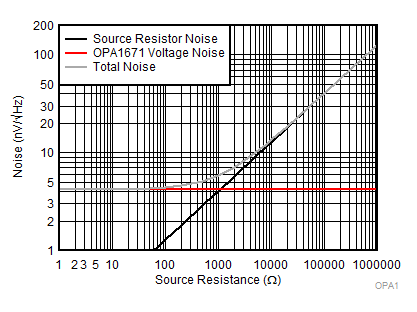ZHCSJ01B January 2019 – August 2019 OPA1671
PRODUCTION DATA.
8.1.2 Noise Performance
Figure 31 shows the total circuit noise for varying source impedances with the operational amplifier in a unity-gain configuration (with no feedback resistor network and therefore no additional noise contributions). The op amp itself contributes a voltage noise component and a current noise component. The voltage noise is commonly modeled as a time-varying component of the offset voltage. The current noise is modeled as the time-varying component of the input bias current and reacts with the source resistance to create a voltage component of noise. For a CMOS-input device, the noise resulting from the input current is negligible; therefore, the total noise is dominated by the voltage noise of the OPA1671 at low source resistance, and the resistor noise > 1 kΩ.
Figure 31 shows the calculation of the total circuit noise, with these parameters:
- en = voltage noise
- RS = source impedance
- k = Boltzmann's constant = 1.38 × 10–23 J/K
- T = temperature in kelvins (K)
For more details on calculating noise, see Basic Noise Calculations.
 Figure 32. Noise Performance of the OPA1671 in a Unity-Gain Buffer Configuration
Figure 32. Noise Performance of the OPA1671 in a Unity-Gain Buffer Configuration